|
|
|
Sort Order |
|
|
|
Items / Page
|
|
|
|
|
|
|
| Srl | Item |
| 1 |
ID:
088907
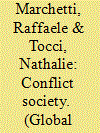

|
|
|
|
|
| Publication |
2009.
|
| Summary/Abstract |
This article analyses the relationship between civil society and conflict. It aims to provide an analytical framework to unpack this complex relationship and assess the impacts which civil society may have on conflict. In a first section, it analyses the implications of context on civil society, namely the implications that statehood, democracy, nationalism, development and international presence have on the nature of civil society. In the second section it examines more specifically the role of civil society in ethno-political conflicts, or as we rename it 'conflict society'. The final section turns to the identification of different factors determining the impact of civil society on conflicts, including political identities, frameworks of action and political opportunity structures in which civil society actors operate. Accordingly, the different combinations of these determinants lead to the formation of civil society actors and ensuing actions that can either fuel conflict, sustain the status quo, or build peace
|
|
|
|
|
|
|
|
|
|
|
|
|
|
|
|
| 2 |
ID:
152301
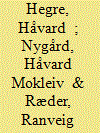

|
|
|
|
|
| Summary/Abstract |
Several studies show that internal armed conflict breeds conflict by exacerbating conditions that increase the chances of war breaking out again. Empirically, this ‘conflict trap’ works through four pathways: conflicts increase the likelihood of continuation, recurrence, escalation, and diffusion of conflict. Past empirical studies have underestimated the scope and intensity of the conflict trap since they consider the impact of conflict only through one of these pathways and rarely across sufficiently long time periods. This article shows that simulation and forecasting techniques are useful and indeed necessary to quantify the total, aggregated effect of the conflict trap, over long time periods and across countries. We develop a country-year statistical model that allows estimating the probability of no conflict, minor conflict, and major conflict, and the probabilities of transition between these states. A set of variables denoting the immediate and more distant conflict history of the country are used as endogenous predictors in the simulated forecasts. Another set of variables shown to be robustly associated with armed conflict are treated as exogenous predictors. We show that the conflict trap is even more severe than earlier studies have indicated. For instance, if a large low-income country with no previous conflicts is simulated to have two to three years of conflict over the 2015–18 period, we find that it will have nine more years of conflict over the 2019–40 period than if peace holds up to 2018. Conversely, if a large low-income country that has had major conflict with more than 1,000 battle-related deaths in several of the past ten years succeeds in containing violence to minor conflict over the 2015–18 period, we find that it will experience five fewer years of conflict in the subsequent 20 years than if violence continues unabated.
|
|
|
|
|
|
|
|
|
|
|
|
|
|
|
|
| 3 |
ID:
177786
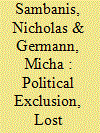

|
|
|
|
|
| Summary/Abstract |
Most civil wars are preceded by nonviolent forms of conflict. While it is often assumed that violent and nonviolent conflicts are qualitatively different and have different causes, that assumption is rarely tested empirically. We use a two-step approach to explore whether political exclusion and lost autonomy—two common causes of civil war according to extant literature—are associated with the emergence of nonviolent separatist claims, with the escalation of nonviolent separatist claims to war, or both. Our analysis suggests that different types of grievances matter more at different stages of conflict escalation. We find that political exclusion is a significant correlate of the escalation of nonviolent claims for self-determination to violence, while its association with the emergence of nonviolent separatist claims is weaker. By contrast, lost autonomy is correlated with both the emergence of nonviolent separatist claims and, if autonomy revocations are recent, their escalation to violence. We argue that these results are consistent with both grievance- and opportunity-based theories of conflict.
|
|
|
|
|
|
|
|
|
|
|
|
|
|
|
|
| 4 |
ID:
083231
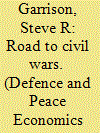

|
|
|
|
|
| Publication |
2008.
|
| Summary/Abstract |
Opportunity structure theories of civil war onset argue that certain societal preconditions lower the costs of rebel mobilization. This approach, however, has not provided an account of how these structures transform lower level political violence into civil war because civil war is treated as a conceptually distinct category of violence. This paper proposes an internal theory of political violence based on the interactions of regimes and challengers. The escalation and de-escalation of political violence is viewed as the product of comparative rates of adaptation. Equal rates of adaptation produce civil war, while unequal rates, termination.
|
|
|
|
|
|
|
|
|
|
|
|
|
|
|
|
| 5 |
ID:
182462
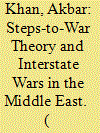

|
|
|
|
|
| Summary/Abstract |
I employ Steps-to-War theory to analyze interstate wars in the Middle East by adding an additional escalating step: state sponsorship of non-state actors. Remarkably, however, the present scholarship completely overlooks a comprehensive assessment of the impacts and roles of state-sponsored terrorism on escalation of interstate militarized conflicts. None of the conflict studies focuses on state-sponsored terrorism and escalation of interstate conflict. This gap still exists despite a remarkable growth in the conflict literature. This article argues that the Steps-to-War thesis is a useful framework for understanding why states end up fighting wars by answering the questions: How does state-sponsored terrorism escalate interstate conflict? And how does each step intertwine with other steps and make war more likely? This paper’s primary argument is that state-sponsored terrorism increases the likelihood of war by providing another escalating step in conjunction with other steps and, therefore, aligns with Steps-to-War theory, and is one of the leading escalating factors. Ultimately, this article argues that this claim has a solid basis, and the Middle Eastern cases vividly demonstrate the escalatory ability of state-sponsored terrorism because state-sponsored terrorism interacts with and reinforces other escalating factors.
|
|
|
|
|
|
|
|
|
|
|
|
|
|
|
|
| 6 |
ID:
094625
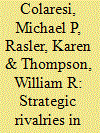

|
|
|
|
|
| Publication |
Cambridge, Cambridge University Press, 2007.
|
| Description |
xiv, 314p.
|
| Standard Number |
9780521707619
|
|
|
|
|
|
|
|
|
|
|
|
Copies: C:1/I:0,R:0,Q:0
Circulation
| Accession# | Call# | Current Location | Status | Policy | Location |
| 054832 | 327.1/COL 054832 | Main | On Shelf | General | |
|
|
|
|
| 7 |
ID:
122533
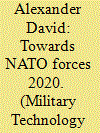

|
|
|
|
|
| Publication |
2012.
|
| Summary/Abstract |
Envisioning the soldier of the future as part of a larger transformation is currently taking place among the members of the NATO alliance. Faced with new threats and challenges, global infantry forces are redesigning themselves as lighter, faster and more agile formations that can be deployed rapidly and effectively, with small units asymmetrically fielding combat capabilities that would exceed those of the present by several orders of magnitude.
|
|
|
|
|
|
|
|
|
|
|
|
|
|
|
|
| 8 |
ID:
190021
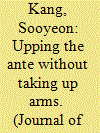

|
|
|
|
|
| Summary/Abstract |
One of the unresolved puzzles in the civil resistance and contentious politics literatures is why some movements that begin seeking limited redress in a certain policy space escalate their claims to demand the ousting of a national leader or the entire regime, a process the article terms ‘demand escalation’. For instance, in the summer of 2019, thousands took to the streets of Hong Kong to protest about a proposed extradition bill that would allow criminal suspects to be sent to mainland China to face trial in courts controlled by the Communist Party. However, even after Hong Kong’s leader, Carrie Lam, announced the formal withdrawal of the controversial bill, protests continued with some calling for greater democracy and others demanding Lam’s resignation. Whereas most of the literature on civil resistance treats demands as fixed and focuses on different methods of struggle to pursue predefined ends, this article shows that demands can change as a result of the state–dissent interaction. The article argues that movements are more likely to escalate their demands when the state responds to the initial nonviolent action with a disproportionate use of force, because such an action intensifies the grievances the protesters have against the state and betrays the remaining trust that people might have had in the government. The analysis of a new quantitative dataset that catalogues both reformist and maximalist opposition campaigns globally supports this claim. By incorporating non-maximalist campaigns into the analysis and not treating demands as fixed, this article adds to our understanding of mass campaigns and highlights an overlooked means by which nonviolent campaigns can up their ante without resorting to violence.
|
|
|
|
|
|
|
|
|
|
|
|
|
|
|
|
|
|
|
|
|